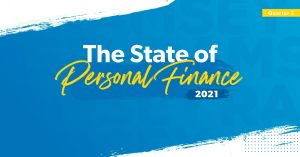Key takeaways
- Even minor adjustments to your finances, like canceling subscriptions or paying with cash, can add up quickly.
- Consider automating both your savings and bill payments to keep your budget in check.
- Regularly evaluate your spending, from bank fees to energy consumption, to uncover opportunities for quick wins.
Our writers and editors used an in-house natural language generation platform to assist with portions of this article, allowing them to focus on adding information that is uniquely helpful. The article was reviewed, fact-checked and edited by our editorial staff prior to publication.
According to Bankrate’s latest emergency savings report, 27 percent of U.S. adults don’t have emergency savings and 59 percent aren’t comfortable with their current emergency savings amount. Besides a healthy emergency fund, usually equivalent to 3 to 6 months of living expenses, saving money can help you break free from the cycle of living paycheck to paycheck.
Whether you want to learn how to save money fast to get peace of mind for unexpected bills or reap the benefits of putting more money away into a high-yield savings account, we’ve compiled a list of 19 tips to help you save money fast.
1. Assess your current financial habits
Before you dive into any of the savings tips, it’s essential to understand your current financial habits. Track your expenses for 30 days to evaluate your fixed and variable costs. Fixed costs are expenses like rent, insurance premiums and car payments that don’t change monthly. Variable costs include grocery bills, gas, dining out and other expenses that fluctuate depending on your lifestyle. Once you get a handle on your finances as they stand today, you can start planning a strategy for the future.
2. Create a budget
Budgeting is a fundamental skill that helps you build financial awareness and literacy. You can budget with pen and paper to tally up daily expenses or use paid or free budgeting tools or apps. Apps such as You Need A Budget (YNAB) or Monarch can help you track spending, set financial goals and save more effectively. Knowing where your money is going allows you to make smarter spending decisions and cut out miscellaneous costs to help you save money fast.
3. Work on paying down debt
Before you go all in on your savings, don’t forget to consider the part of your financial life that can actively eat into your monthly savings: interest rates on your debt.
Look at any debt with higher interest rates, like your credit card balance, and tackle that first. And remember, you can and should still contribute to your savings while paying down your debt.
4. Consider alternate forms of transportation
According to a research study by the Bureau of Transportation Statistics, 52% of all trips are less than three miles and 28% are less than one mile. Assuming you have the necessary infrastructure to do so safely, swapping your car for a bicycle or walking can save you hundreds of dollars over the course of a year. However, your savings will vary depending on how often and what distances you drive and gas prices.
5. Cancel unnecessary subscriptions and memberships
A certificate of deposit (CD) allows you to save money for a set amount of time. CDs are a great way to grow your savings if you can afford to lock away some money for a short period. They offer a fixed interest rate, often higher than savings accounts. Currently, one-year CDs can yield around 4–5 percent APY, a solid return on your money.
6. Automate your savings
Many online banks and apps like Qapital allow you to automate your savings by regularly rounding up your purchases or transferring small amounts into your savings account.
Automation ensures you are consistently putting money away without manual intervention.
7. Set up automatic bill payments
Setting up automatic payments for your bills can help you avoid late fees, which the Consumer Financial Protection Bureau reports can cost hundreds per year. Automatic payments may also qualify you for discounts from utility companies or lower interest rates from loan providers.
While automated payments are convenient, it’s vital to ensure that your account always has the funds necessary to pay your bills in full. If your account is overdrafted from an automated payment, you may get hit with overdraft fees from your bank as well as late fees if the service provider or other party doesn’t get the requested money on time.
8. Switch banks for better interest rates and fewer fees
Traditional banks may charge fees that chip away at your savings. Consider switching to an online bank, many of which offer fee-free checking and higher-interest savings accounts. Online banks can offer APYs of up to 5 percent, compared to less than 1 percent with traditional banks.
9. Open a short-term certificate of deposit (CD)
A certificate of deposit (CD) is a great way to grow your savings if you can afford to lock away some money temporarily. They offer a fixed interest rate, often higher than savings accounts. Currently, one-year CDs can yield around 4–5 percent APY, a solid return on your money.
10. Use rewards and loyalty programs
Joining rewards programs at grocery stores, pharmacies or retail chains can lead to significant savings. Loyalty programs can save households hundreds of dollars annually, especially with coupons and special offers. With that said, be wary of promotional offers that tempt you into spending more than you had planned.
11. Pay with cash or set spending limits
Psychologically, it’s harder to part with physical cash than it is to swipe a card, so paying with cash for everyday expenses can curb impulse purchases like that new game or the next round of drinks.
On the other hand, if a credit card fits your lifestyle better, you can take advantage of some safety nets. For example, many banks allow you to set spending limits or alerts on your credit cards, which help control your spending and avoid losing money.
12. Stop paying for convenience services
Americans spend a lot on convenience services — over $400 per month on delivery alone. To start recouping some of that money, stop outsourcing your services and “insource” instead. Opting to cook at home or do minor household repairs can quickly add to significant savings.
13. Earn cash back on everyday purchases
If you need to use credit, make sure you’re getting rewarded. Apps like Rakuten and Ibotta provide additional cash back savings when shopping online or in-store. Cash back credit cards like Chase Freedom or Discover It offer up to 5 percent cash back on rotating categories such as groceries, dining and online shopping. Just remember to pay off the balance each month to avoid interest charges.
14. Buy in bulk
Buying in bulk from stores like Costco or Sam’s Club can save you a lot of money in the long term, particularly for non-perishable items. Bulk buying can reduce your shopping costs significantly, especially if you’re carefully watching the cost per unit (CPU).
However, be cautious — buying perishable goods in bulk could lead to food waste. Make sure to store items properly to maximize shelf life.
15. Clip coupons
Sites like Honey and RetailMeNot make finding and applying digital coupons at checkout easy. According to CouponFollow, a leading coupon company, households that use coupons save an average of $1,465 annually.
Pair coupon usage with in-store promotions for deeper discounts, and automate your coupon clippings by installing a mobile app or browser extension that automatically finds and applies coupons at checkout.
16. Reevaluate your housing costs
Housing often accounts for the most significant chunk of your budget. Renters can save money on rent by negotiating rent reductions in exchange for signing longer leases.If you’re a homeowner, you could reduce housing costs with a refinanced mortgage. Refinancing when lower interest rates are available is a smart idea if you plan to live there for at least two more years. If your interest drops from 7.5% to 6%, a mortgage refinance could lower your monthly payments by $500 and save you nearly $200,000 in total interest.
17. Shop for better insurance rates
Many people stick with the same insurance provider for years, not realizing they could save hundreds by switching. Shopping around and comparing quotes on car, home or renters insurance can lead to big savings. You can also consider bundling your home and car insurance for the best deals.
18. Use a no-fee credit card
If your credit card charges an annual fee, consider downgrading to a no-fee option. Many companies, like Citi or American Express, offer no-annual-fee credit card alternatives that still provide rewards without the added cost.
19. Plan no-spend days
No-spend challenges are an effective way to reset your budget and become more mindful of unnecessary expenses. Challenge yourself to go without spending money on anything outside of essential costs like groceries, bills and transportation for a set period, like one day per week or one week per month.
20. Eliminate one spending habit
Eliminating one costly habit — whether it’s your daily coffee, subscription boxes or online shopping sprees — can save hundreds, if not thousands, annually. Identify a habit and commit to reducing or eliminating it to free up extra cash for savings.
The bottom line
Before you take the first steps on your savings journey, it’s critical to get a pulse check on your overall financial wellness. Once you know your spending habits, expenses and debts compared to your income, you can formulate a plan to meet your future financial goals, whether that’s adding to your emergency fund, paying off your student loans or planning for a vacation. Take the first step today and download a budgeting app to save money fast and get your financial life under control.
Read the full article here










